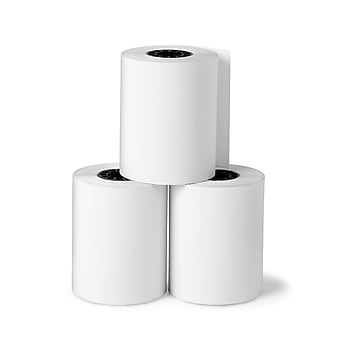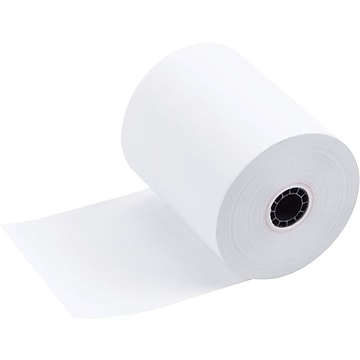Gas Pumps POS Paper
Best Match
Grid view
Pick up and Delivery
Brand
POS Paper Usage
POS Paper Roll Width
POS Paper Type
Color Family
Related Searches
Trending now
Page 1 of 4
Many gas stations no longer have outdoor attendants serving in the forecourt area that houses the fuel pumps. Most pumps accept only debit or credit cards. Gas pump paper goes in fuel dispensers to provide receipts for gas customers who don't want to walk into a brick-and-mortar building to pay cash. Staples® provides many POS paper rolls that fit the leading types of fuel-dispensing pumps.
Gas Pump Paper Comes in Different Sizes for Different Pumps
Customer receipts for gas purchases come in gas pump paper rolls. The rolls consist of what is known as point-of-service, or POS, paper. The rolls have different widths depending on the specific model of fuel pump. The common width is 2.25 inches, fitting the receipt slot of fuel pumps made by most of the major brands. The gas pump paper rolls vary in length from 85 to 400 feet, appropriate for specific paper receipt housings among the different models. The paper works with computer memory, readout, and print-head technology inside the fuel pump, and is part of a larger POS system consisting of a remote monitor, hard drive, and customer display screen.
POS Gas Pump Paper Operates With Thermal Paper Technology
The paper for fuel dispensers has one layer that contains a transparent dye that turns to usually a black color when heated. This thermal layer is sandwiched between a backing paper or thin plastic substrate and a top coating that protects the transparent dye from any element other than the heat of the print head inside the pump. Just about 70 percent of thermal POS paper is for receipt printouts, and designed specifically for small thermal printers that are housed inside terminals in either a vertical or horizontal position.
How Many Receipts Can Rolls of Gas Pump Paper Print?
POS paper receipts average 2 inches long, depending on the type of data that a gas station wants to be printed on the receipt and on the model of the gas pump itself. The amount of receipts that each roll yields also depends on its length. Each roll has a warning stripe before the end to indicate that it needs changing.
Can Gas Pump Paper Be Used in Other Receipt-Dispensing Machines?
Gas pump paper rolls may have cross applications with some other POS credit and debit card terminals. You should always check specifications. The standard 2.25-inch rolls, for example, do fit certain credit card transaction devices with receipt printout capability.
Do You Have to Be Careful in Handling Gas Pump Paper?
The thermal coating of POS gas pump paper rolls can scratch and abrade easily, which may chip off parts of the print-accepting dye and discolor the paper by exposing the underlying substrate. It’s best to store gas pump paper rolls in their original packaging in a dry, cool storage area without exposure to light, such as a file cabinet. The paper should not come in contact with other substances containing plastics, which may interact with the thermal dye and cause it to fade. Other substances that may affect the integrity of the paper include vinyl, adhesives, carbon paper, cleaning fluids, and oils.
Gas Pump Paper Comes in Different Sizes for Different Pumps
Customer receipts for gas purchases come in gas pump paper rolls. The rolls consist of what is known as point-of-service, or POS, paper. The rolls have different widths depending on the specific model of fuel pump. The common width is 2.25 inches, fitting the receipt slot of fuel pumps made by most of the major brands. The gas pump paper rolls vary in length from 85 to 400 feet, appropriate for specific paper receipt housings among the different models. The paper works with computer memory, readout, and print-head technology inside the fuel pump, and is part of a larger POS system consisting of a remote monitor, hard drive, and customer display screen.
POS Gas Pump Paper Operates With Thermal Paper Technology
The paper for fuel dispensers has one layer that contains a transparent dye that turns to usually a black color when heated. This thermal layer is sandwiched between a backing paper or thin plastic substrate and a top coating that protects the transparent dye from any element other than the heat of the print head inside the pump. Just about 70 percent of thermal POS paper is for receipt printouts, and designed specifically for small thermal printers that are housed inside terminals in either a vertical or horizontal position.
How Many Receipts Can Rolls of Gas Pump Paper Print?
POS paper receipts average 2 inches long, depending on the type of data that a gas station wants to be printed on the receipt and on the model of the gas pump itself. The amount of receipts that each roll yields also depends on its length. Each roll has a warning stripe before the end to indicate that it needs changing.
Can Gas Pump Paper Be Used in Other Receipt-Dispensing Machines?
Gas pump paper rolls may have cross applications with some other POS credit and debit card terminals. You should always check specifications. The standard 2.25-inch rolls, for example, do fit certain credit card transaction devices with receipt printout capability.
Do You Have to Be Careful in Handling Gas Pump Paper?
The thermal coating of POS gas pump paper rolls can scratch and abrade easily, which may chip off parts of the print-accepting dye and discolor the paper by exposing the underlying substrate. It’s best to store gas pump paper rolls in their original packaging in a dry, cool storage area without exposure to light, such as a file cabinet. The paper should not come in contact with other substances containing plastics, which may interact with the thermal dye and cause it to fade. Other substances that may affect the integrity of the paper include vinyl, adhesives, carbon paper, cleaning fluids, and oils.

















































